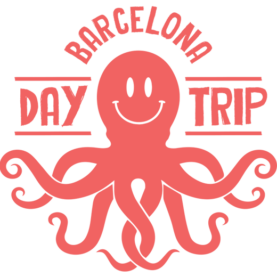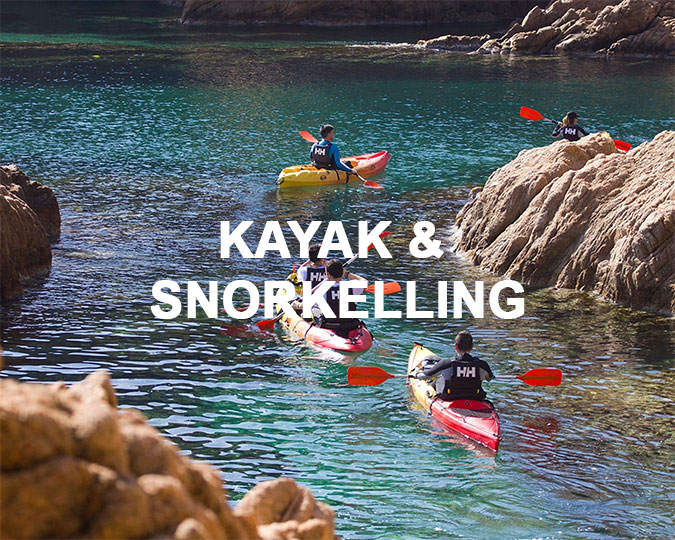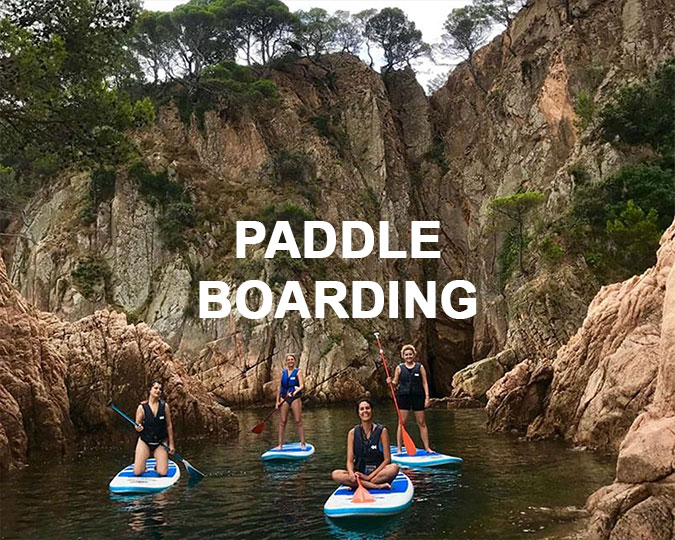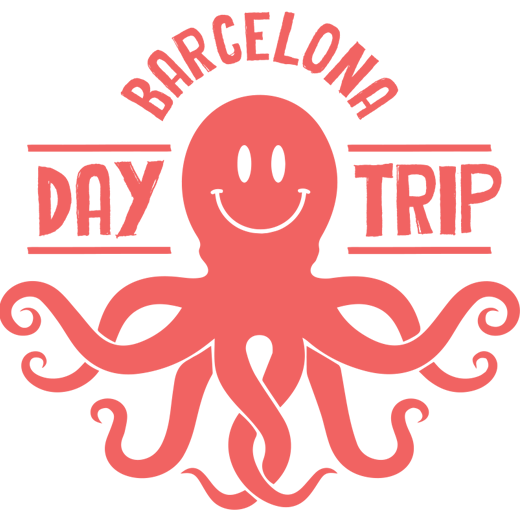
COSTA BRAVA SEA LIFE GUIDE
Costa Brava sea life and snorkelling guide
We are going to show you our top pics related to underwater sea life, the main species that we can find, and the main species of both flora and fauna in the area. In the Mediterranean there are around 17,000 species of which 20% are endemic to the area, that is to say, they are species that are exclusively found in the Mediterranean.
We are going to deal especially with species that are common in shallow rocky areas. In this guide, you'll find all the species we'll have the most chance of seeing while snorkelling with us on your day trip to the Costa Brava, today, tomorrow or hopefully soon!
We are going to divide our list into categories of things you may see on the snorkelling and kayaking parts of our tours, starting with snorkelling itself:
- Snorkelling - The basics
- Invertebrate animals
- The most common fish we can find in La Costa Brava and while we are snorkelling
- Medium to large common fish we usually see
- Whales and dolphins we're very lucky to see when we do
- Plants, trees and different rock formations create the picturesque Costa Brava coastline
- Sea birds whose main habitat is next to the sea
Snorkelling - The basics
Want to snorkel but never tried before?
We welcome you to enjoy our quick and easy guide to snorkelling for the first time, in four simple steps.
Remember when you're snorkelling (with all standard masks), you're only breathing through your mouth, not your nose. It's a strange feeling that soon passes, so we're confident that anyone can learn, practice, and quickly feel comfortable to enjoy the water, and all the sea life it supports.
Step 1 - Make sure your mask and tube fit before you go
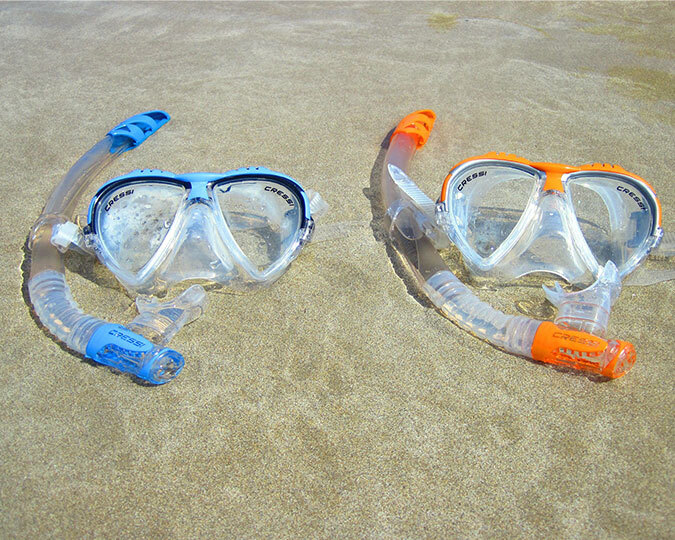
There is a wide variety of choice when it comes to buying your gear, from masks that cover your whole head and face (with no tube), to extended tubes, flippers and even fins. For now, we're keeping to the standard and mostly widely used and recognised, the simple mask and tube.
The mask (goggles to see through), and the tube (that you breathe with). Normally these two are connected in order to keep the tube in place and out of the water, for a comfortable experience. Place the goggles on first and make sure they fit your face. They will cover your nose (which helps you to only breathe only through your mouth).
A good fitting pair will create a slight suction when pushed gently on - which should be enough to hold them over your face and nose for a few seconds before falling off again.
If they're not a good fit, there will be no suction around your eyes and nose.
The tube's mouthpiece is designed as a kind of 'bit' (similar to that used with a horse), which you put inside your mouth so that the plastic sits between your teeth and the inside of your lips.
The tube itself will rest on your face, clipped to the strap of the goggles. The tube should lean against the side of your head with the top facing up. The top part sucks in oxygen when you breathe and will be out of the water when your head is facing down, so you can view all the sea life.
Step 2 - Breathe normally
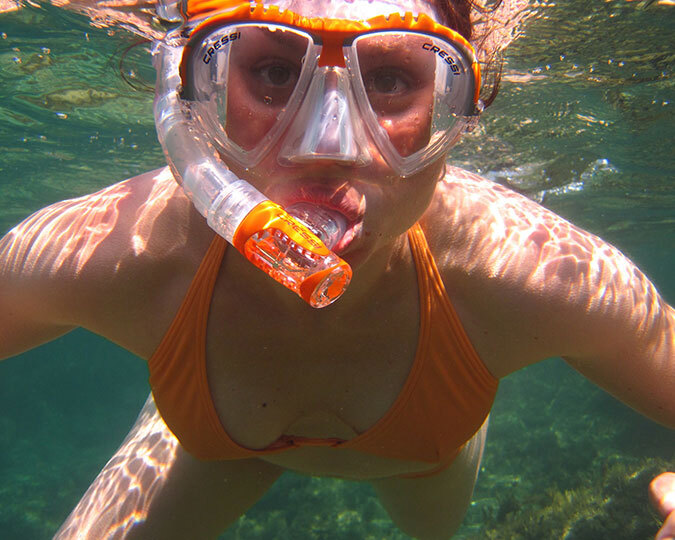
Now you have your gear fitting properly, let's go to the sea and practice breathing before you dip your head down into the water and start swimming.
The tube's mouthpiece is designed to create a seal around the mouthpiece while you breathe air in and out, meaning no water can enter from the top of the tube.
Likewise, the goggles are designed to help you stop breathing through your nose. This is important as if you blow air from your nostrils, it will create a little pressure in the mask, and allow water to seep inside your goggles forming little tiny puddles around your eyes.
So firstly, we'll get used to only breathing through our mouths. It's a strange and unnatural feeling but trust me, you'll have more than enough oxygen to swim around at a leisurely pace.
With the mask on and the tube in your mouth, take some natural, normal breaths through your mouth (not your nose), and get used to the feeling.
Then, when you're ready; from standing in a shallow area, slowly submerge your face into the water, breathing steadily through your mouth and keeping your eyes open.
You'll see that the tube remains above the water while your face is submerged and while breathing naturally, you can swim around the surface admiring all of the life below.
It's truly a wonderful experience that even our guides (who do it every day), continue to find fascinating.
Step 3 - Hold breath to dive, then clear tube at the surface to breathe
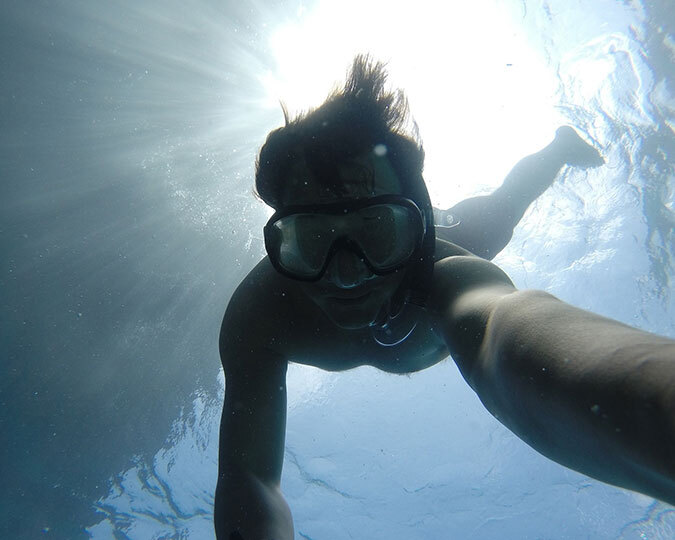
Ok so you're swimming comfortably across the surface of the water enjoying the sea bed in all its beauty.. but then, what's that? A shinny, shimmering coin? A ring? Gold? Pirate treasure?! What could it be... all I know is, you should 100% go and take a closer look.
Remember there are a lot of snorkel masks and some of them have the inbuilt capability to stop water coming inside the tube however, most of them don't.
In order to dive down and have a look at our treasure we need to remember that when fully submerging the top of the tube will suck in water instead of air.
This means two things, when you're underwater, you need to hold your breath (as you normally would when diving down), as water will travel down the tube and enter your mouth if you try to breathe while submerged. Number two, is before you breathe again after surfacing, you must clear the tube of water.
You can choose to do this completely out of the water (standing up or treading water), or, my preferred way is to remain snorkelling and blow the water out like a WHALE.
- Hold breath and dive down to inspect treasure
- Surface with your body but keep your face underwater so the top of your tube is again above the water level (and will suck in air, not water)
- Blow out all the air from holding your breath like a whale
- Breathe normally again with air in your tube
Step 4 - Relax and enjoy

So now you can check your equipment, practice out of the water, ease yourself under the surface, swim around to spot treasure on the sea bed then dive for it and resurface clearing your tube to continue...
You're ready to go! Relax and enjoy all of the beauty and sea life the Mediterranean sea has to offer.
Keep an eye out for some of the species we list below and 'Bien suerte', good luck on your first underwater adventure.
Sea life: The fun stuff - you should see some of these
Invertebrate animals
We are going to start with the invertebrate animals that we can find while snorkelling, the list is very diverse and goes from our favourite animal which is the octopus, to different types of anemones such as sea tomatoes and starfish.
Common octopus
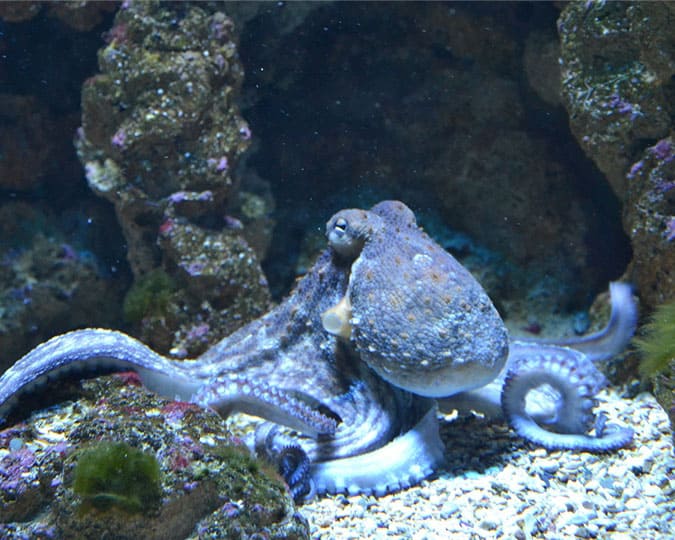
"Octopus Vulgaris" Pulpo común in Spanish.
It is difficult to see the octopuses since they camouflage themselves very well in the environment and can change their skin colour and even texture, they are also mainly nocturnal animals, during the day they tend to hide in crevices.
Common cuttlefish

"Sepia Officinalis" Sepia in spanish.
The cuttlefish has a shell on its head under the skin. It has a body with tentacles. They usually measure up to 40 cm, as a peculiarity it can camouflage itself and change the colour of its skin. One of the most fun additions to sea life in the area.
European squid

"Loligo vulgaris" calamar in Spanish.
The European squid is normally about 15-20 cm in size. They have 10 arms, 8 relatively short and 2 longer that are used to hunt. They are found from the surface to depths of up to 500 m and are nocturnal animals, so it is very rare to see them during the day.
Red starfish

"Echinaster Sepositus" estrella roja de mar in Spanish.
They are made up of a central disc and usually 5 arms, although you can find some with 6 or 7 arms. Underneath they have small tube feet that they use to move around. As a curiosity we will say that they can regenerate in case of splitting, it is usual that 2 complete starfish come out of two halves.
Sea urchin
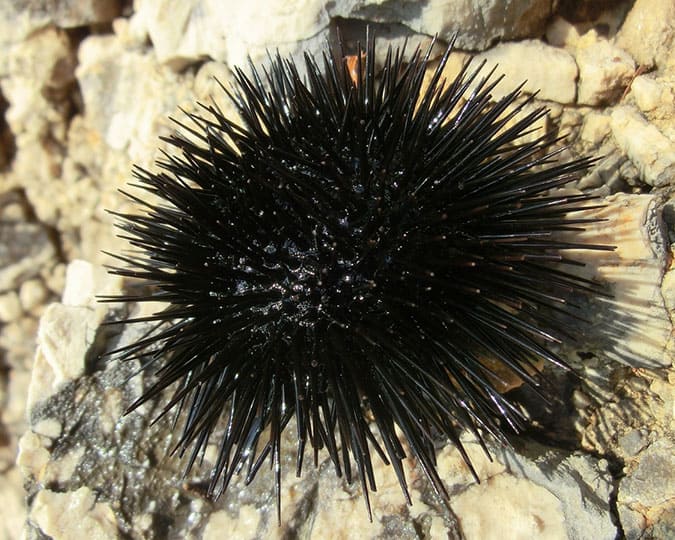
"Paracentrotus Lividus" erizo de mar in Spanish.
Sea urchins are up to 6 to 7 cm in size, with the body covered in robust spines of the same size as the body. It's a herbivorous animal that feeds on algae on rocks. They cling to rocks by tiny tentacles on their lower body. They are quite common and share a habitat with the Arbacia lixula species. They are an appreciated culinary delight.
Beadlet anemone
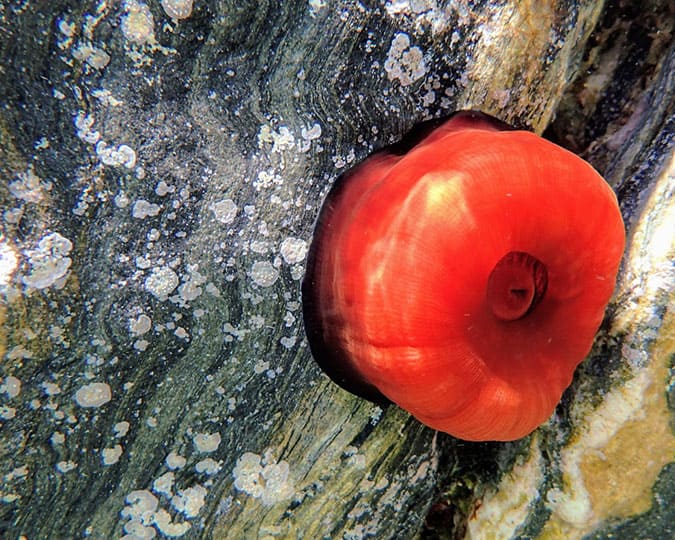
"Actinia Equina" Tomate de mar in Spanish, or sea tomato in English.
It is a kind of sea anemone, with retractable tentacles, when they are hidden they are completely round with a rounded shape similar to that of a tomato hence its name. It feeds on small fish and molluscs. Their tentacles can be a bit stingy.
You should see lots of these friendly little fish
Most common fish we can find while snorkelling for sea life
We are now going to look at a list of the most common fish, talking about the smallest fish, also called rock fish, they are small fish that live mainly in shallow coastal areas and take shelter in cracks and holes in the seabed.
Mediterranean rainbow wrasse
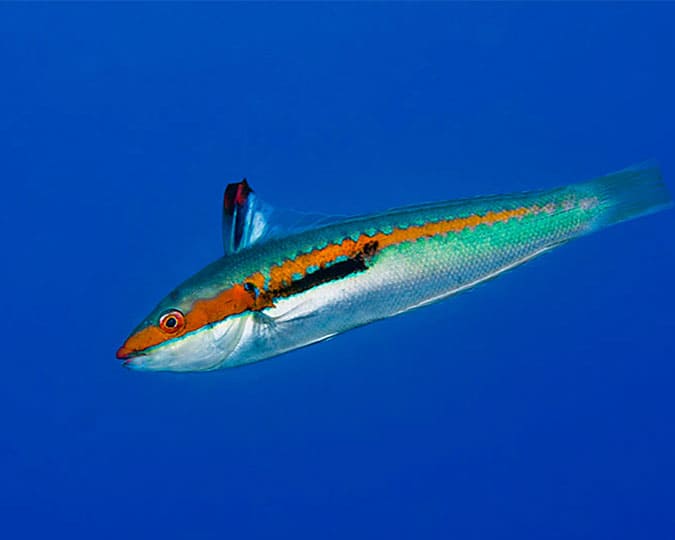
"Coris julis" La Doncella in spanish.
It's a small fish with very bright colours.
Painted comber

"Serranus scriba" La vaqueta in Spanish.
It is also a small fish, it is common to find it in shallow areas.
Damselfish

"Chromis chromis" La castañuela in Spanish.
Small dark coloured fish, thanks to its colour it is well camouflaged on rocks.
Ringneck blenny
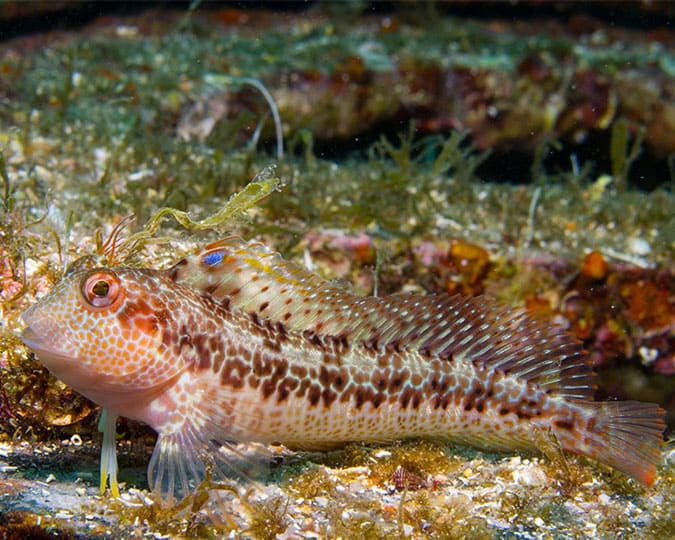
"Parablennius pilicordis" La barriguda in Spanish.
It's a fish of small dimensions it is common to find it in shallow rock areas.
Montagu's blenny
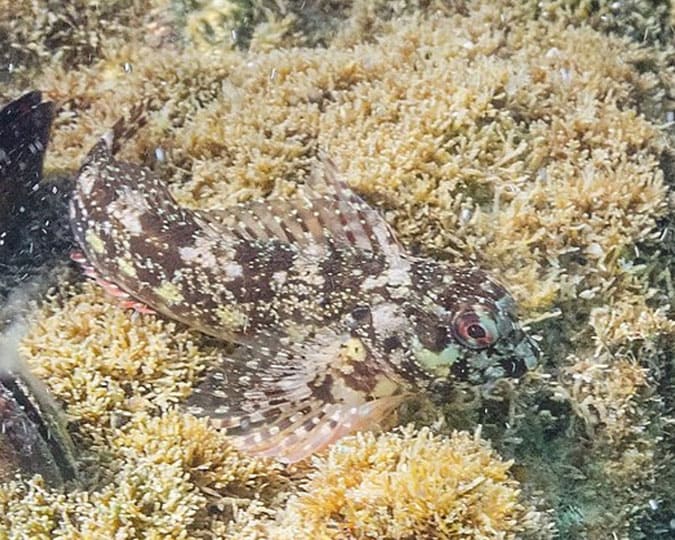
"Curyphoblennius galerita" La mona in Spanish.
It's small fish and is common to find it in shallow rock areas.
Small red scorpionfish
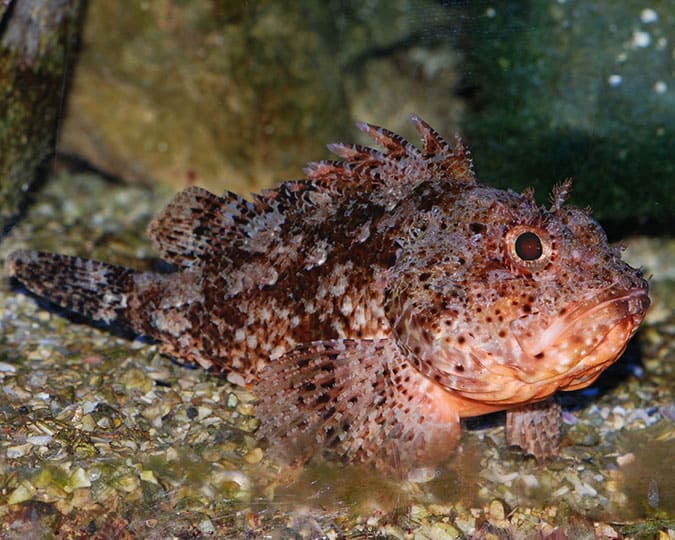
"Escorpaena nonata" Escórpora in Spanish.
These little fish, have small poisonous spines that can cause swelling.
Sea life: The big boys - We usually see some of these in big schools
Medium to large common fish we usually see
We are going to follow the list of the most common fish, with medium to large fish these fish can be seen both in shallow areas on the coast, and in deeper areas further from the coast.
Gilthead Sea-bream
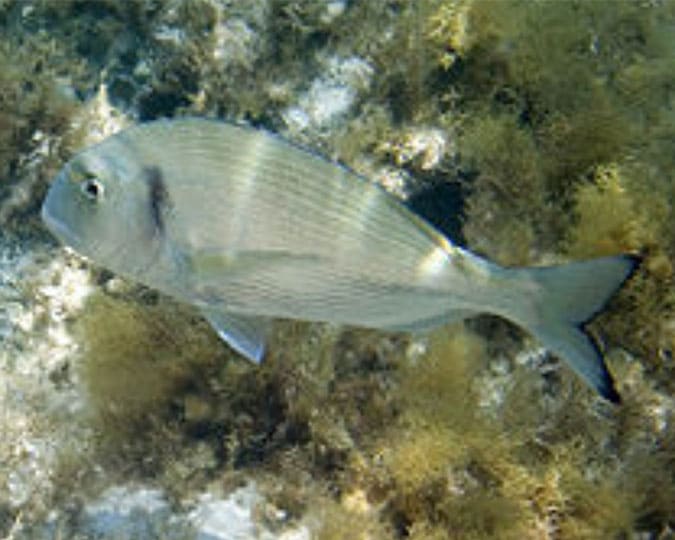
"Sparus aurata" Dorada in spanish.
These medium-sized fish are quite common in the Mediterranean. It is a silver-coloured fish that is highly valued as a culinary delicacy.
White Sea-bream
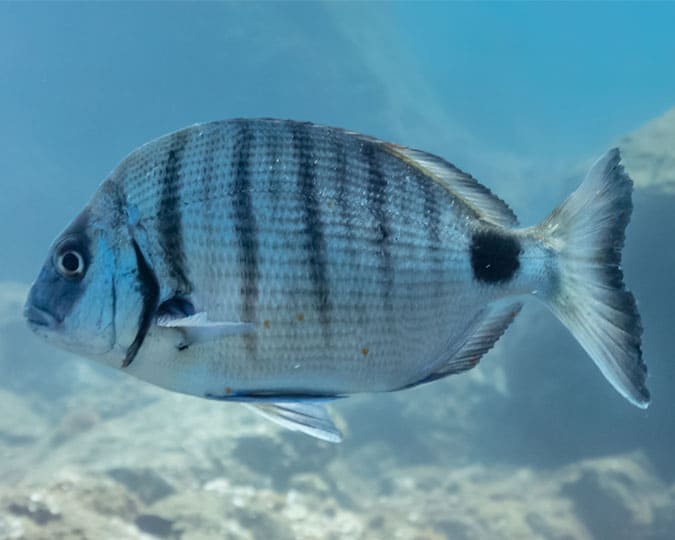
"Diplodus sargus" Sargo in spanish.
It's very similar to the previous one, the Sea-bream, to differentiate it we can see some black vertical lines on the sides of the fish, as it grows they fade, even disappearing in large specimens.
Saddled Sea-bream
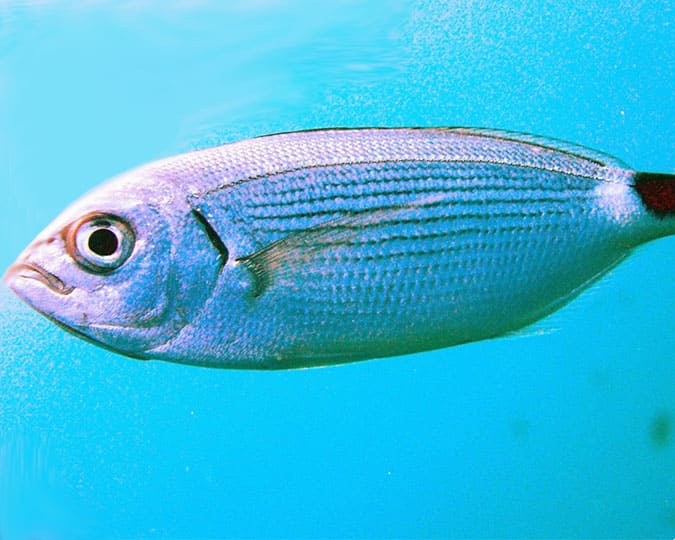
"Oblada melanura" Oblada in Spanish.
These medium-sized fish are common in the Mediterranean. It's a silver-coloured fish and to recognise it while you're snorkelling... they have a black spot at the base of the tail.
Salema
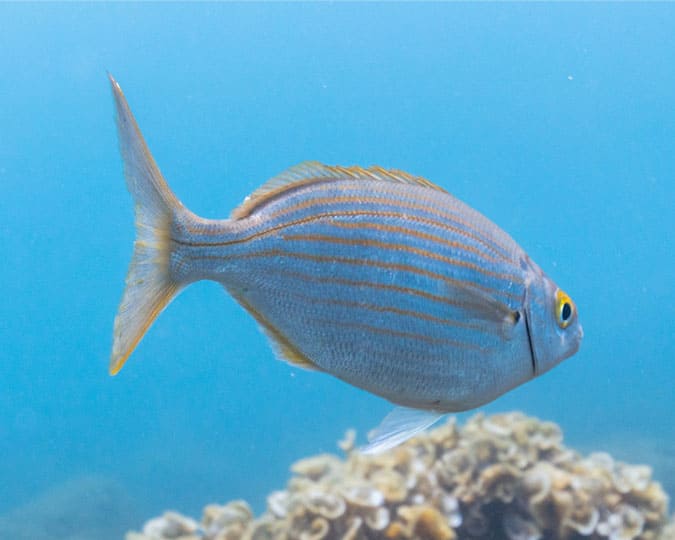
"Sarpa salpa Salpa" in Spanish.
A medium-sized grey fish, recognisable by longitudinal stripes, usually it has between 10 and 11 stripes in a golden or yellowish colour.
Common Dentex

"Dentex dentex" Dentón in Spanish.
Medium-sized fish, although they can measure up to 1 meter. It is named for the large teeth it has, and its powerful jaw, it is primarily a carnivorous fish but it won't eat you 😉
Red Sea-bream

"Pagrus pagrus" Pargo in Spanish.
Medium-sized fish that can reach more than half a meter in length, it can be found practically all over the world, it is recognised by its short and solid body, covered by silver-pinkish scales, with yellowish bands.
Common pandora

"Pagellus erythrimus" Pajel in Spanish.
Medium-sized fish. It has an oval body and a little flat on the side. It is a grey fish and can be recognised thanks to a reddish area right where the body begins
John dory

"Zeus Faber" Pez de Sant Pedro in Spanish.
Medium-sized fish with a fairly flattened body. The name comes from the gospel, it says that the apostle Saint Peter caught the fish with his fingers and took a gold coin from his mouth. It has two black marks one on each side that is supposed to be where Sant Pedro caught the fish.
Sun fish
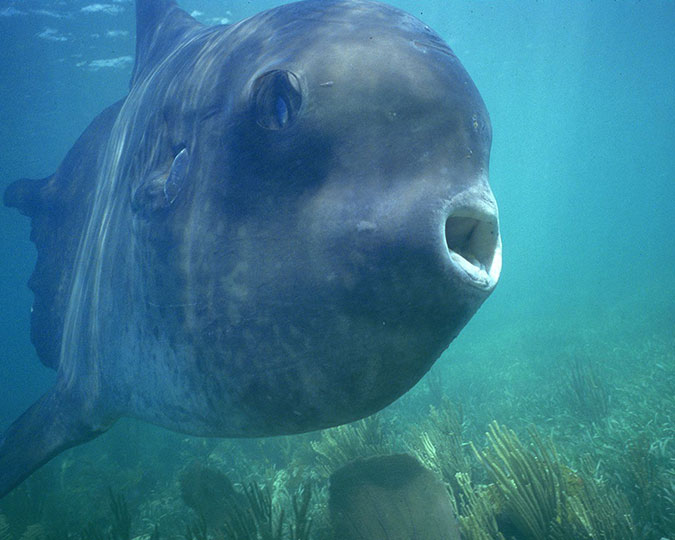
(Mola mola)
With adults weighing in at up to 1000kg, this is one of the heaviest bony fish in the world. The main body is flattened laterally, so it resembles a huge fish head with disproportionate fins and tail. A very funny looking creature, not that common to see but unforgettable if you do.
Manta

(Mobula mobular)
This type of manta ray is on the endangered list of species. As I'm writing this sentence I've seen one of them in the Mediterranean so far. We hope Covid 19 gave them a break and we'll see more in our waters. Very graceful and beautiful to watch swimming.
You'll be lucky to see these beauties
Whales and Dolphins
If you're very lucky, it is possible to catch a glimpse of whales and dolphins from the coast of the Costa Brava. You must be here in the correct season, (spring for whales) and very very lucky. But, it's not impossible to enjoy some of the most graceful beasts of rare sea life in this area.
Fin or Finback Whale

Balaenoptera physalus - The fin or Finback whale.
Fin whales migrate every year along the Catalan coast, across the Balearic Sea (north-western Mediterranean basin). Despite being previously unknown by the scientific community, sightings have been common in recent years.
Second in size only to to the Blue Whale - the largest creature on earth


Weighing in at up to 114 tones and reaching almost 30 metres (around 90ft)
There is an interesting study in the Garraf area (between Barcelona and Tarragona) wherein local fishermen have reported to have seen Fin whales for decades. Their migration movements within the Mediterranean are still poorly understood.
Fin whales can travel in bursts of up to 46km/h and sustained speed between 37-41kmp/h giving it the nickname 'Greyhound of the sea'
So the Fin Whale Project aims to study and collect information on these magnificent creatures so that we might learn more about their behaviour, habits and migration patterns.
Bottlenose dolphin
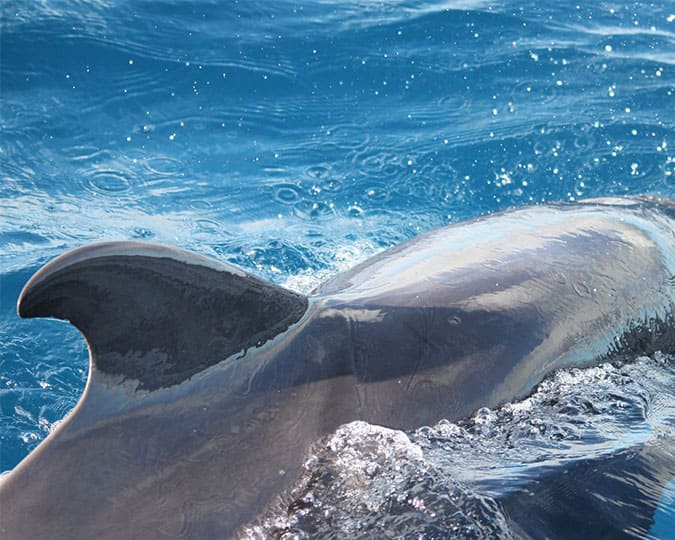
(Tursiops truncatus)
Beautiful and quite common across the globe. Playful, intelligent and graceful. Bottlenose dolphins can use tools, talk to each other and even recognise each other.
Striped dolphin
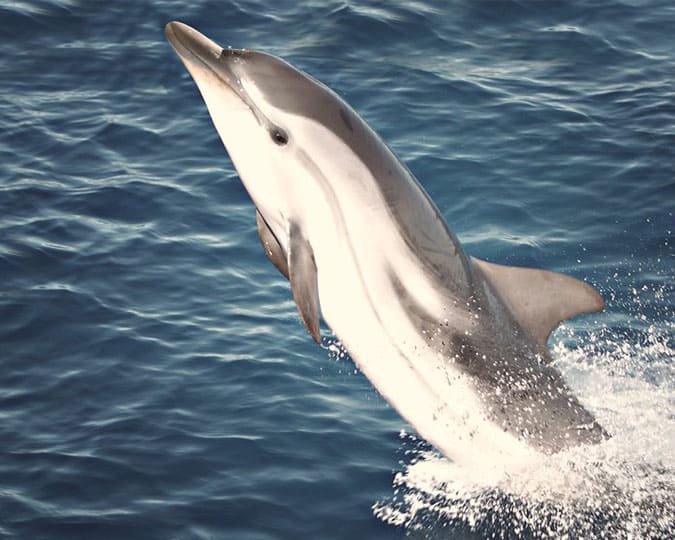
(Stenella coeruleoalba)
Usually found in large pods, the striped dolphin can easily be recognised for, you guessed it, It's white, blue or even pink stripes. Beautiful creatures that are a lot of fun to observe from a kayak.
Habitat on the coast
Trees and rock formations
Although not as obviously exciting or engaging as dolphins or sea life in general, the following (mostly) living things make up the coastal habitat for millions of insects, small animals and birds. This helps to create a thriving ecosystem of natural beauty that is a true marvel. Most of which can be observed as we traverse the Costal waters of the Costa, by kayak or Paddleboard.
Trees

The Costa Brava has Mediterranean weather and so shares the most common trees with other Mediterranean countries.
The most common individual tree we see on the coast is the Holm Oak tree. They are also the most common single tree species in Catalonia, accounting for almost a quarter (24.4%) of the total number of species.
However as a family, pine trees are the most common collectively, with 36% of the total distributed of trees. Red pine (15.6%), White pine (11.8%) and Pinaza pine tree (10%). Finally oak trees with (9.4%).
These five species add up to 71.2% of the total so you're sure to see them on our tour.
(Quercus suber) Cork Oak
The Holm Oak is the most common tree in Catalonia and particularly the Cork Oak in the area of the Costa Brava where historically there has been an industry related to cork from this tree the cork is extracted from which wine stoppers are made among other applications.
Pinus alepensis
This little guy is a type of pine that we find along the coast, near the sea. It doesn't ordinarily grow to a large size and is capable of rooting directly in rocks. It also has branches and a trunk that appear quite twisted, making it quite easy to recognise. This pine is also highly resistant to drought making it a very hardy species.
Rock formations
The rocks that are predominate in the Costa Brava are rocks of granite origin, more specifically of the leucogranite type, it's characterised by the low proportion of black minerals, the whitish and pinkish minerals are dominant.
This type of rock formed about 288 million years ago in the early Permian period.
The main minerals that make up granite are quartz that gives the white tones of the rock, feldspar that gives it a pinkish tone and finally mica, which is the component that gives the black tones of the rock in the area.
In the sky
Sea birds, that live next to the sea
Among the most common birds you will all know the seagulls, but maybe you are not so familiar with the other two species that we are going to show you, it's always nice to watch the magnificent underwater fishing bird the cormorant, or the more rare kentish plover.
Mediterranean Shearwater
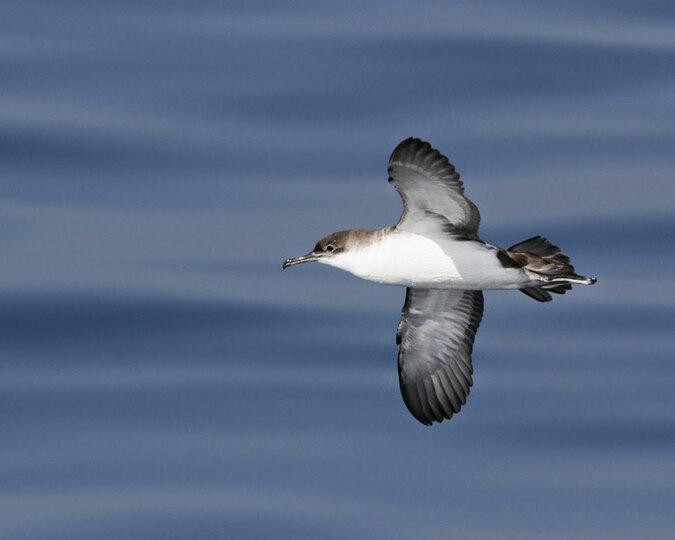
The Mediterranean Shearwater is a medium-sized seabird
They are about 35 cm long and a width of 75 to 90 cm, as a characteristic it has the upper half of the plumage of dark tones and the lower part white. It is found mainly in the Mediterranean and in the Black Sea. It feeds mainly on fish and squid, it breeds on the coastal cliffs, and even with a significant decrease in numbers, it is not endangered yet...
Cormorant
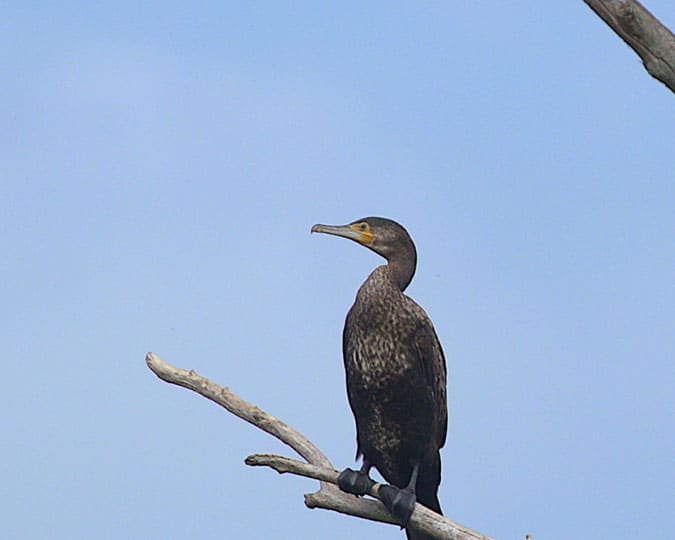
Phalacrocorax in Latin Cormoran in Spanish.
An aquatic bird that feeds on fish it catches underwater, it is an excellent swimmer. Unlike other aquatic birds its feathers are not totally waterproof, which allows it to gain weight and thus dive and submerge more easily. It build it's nests on cliffs, with easy acsess to food and beautiful views.
Kentish plover
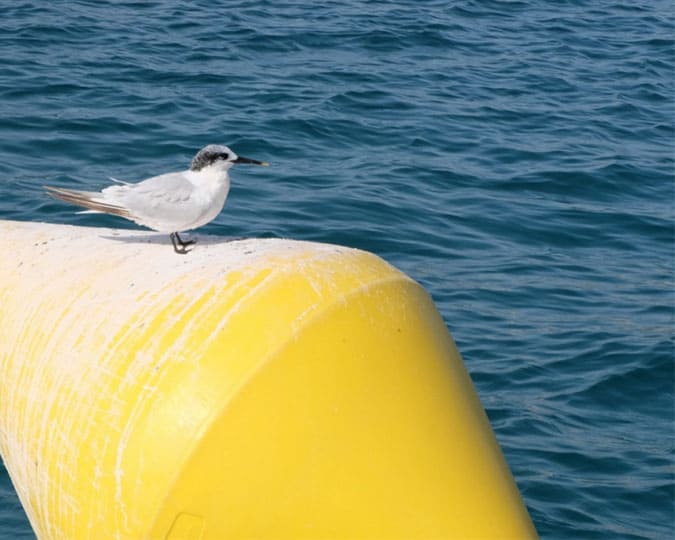
A small shore bird, who live mainly near the sea or next to lakes.
It feeds mainly by catching small animals from between rocks, they also feed on the remains of marine plants that remain on the rocks. This bird is very geographically diversified. To identify them, you may observe from a distance that they have black beaks and legs.
Seagulls
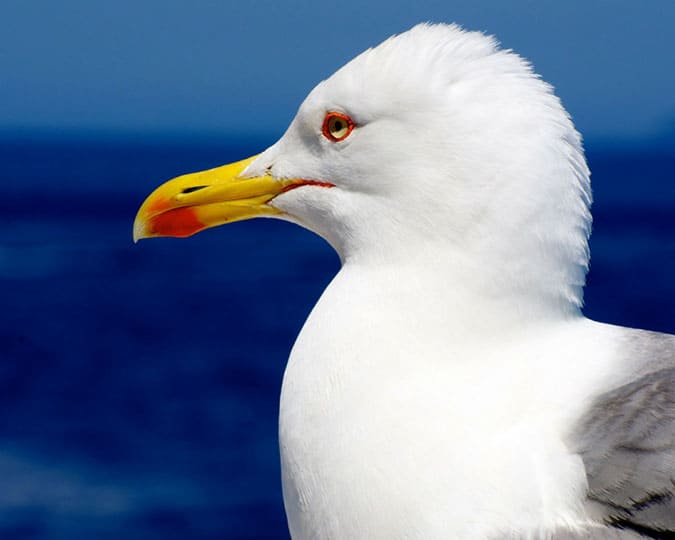
These medium to large-sized birds live mainly near coastal areas often feeding on sea life.
They can also be found near reservoirs or lakes in inland areas. Omnivorous birds, although carnivorous feeding predominates in their diet. They have white fethers with some black spots on the wings or on the head. The young birds have grey plumage so are easily identified as adolescents. They are curious and intelligent birds.
Also check out our guide to the Costa Brava...
Explore more
